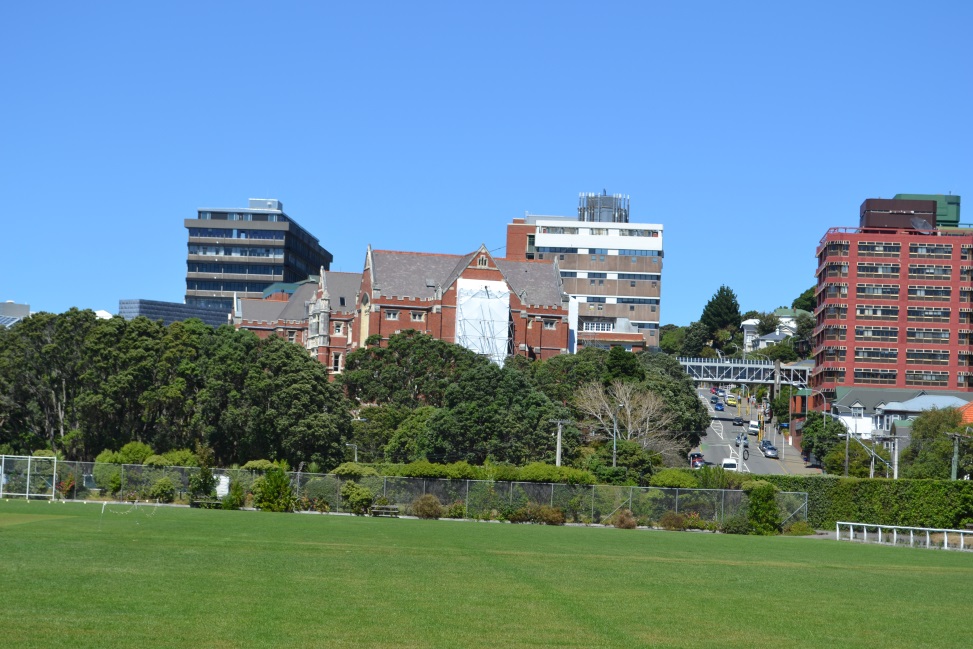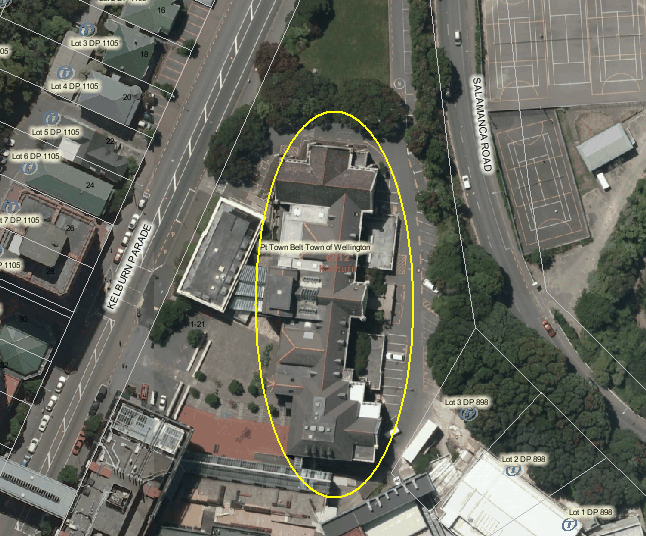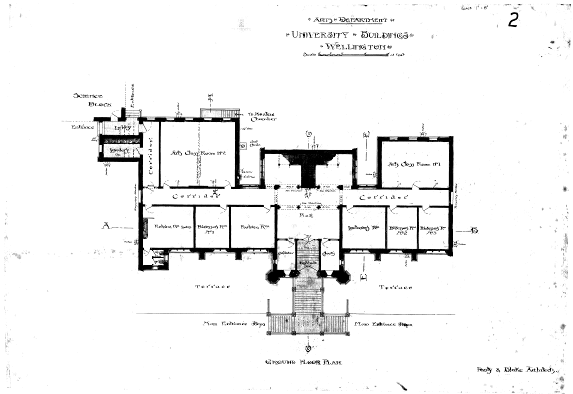Hunter Building, Victoria University
(North Wing/Memorial Library/Arts Building/Physics Wing)
-
Constructed
1904
-
-
Architect(s)
-
Builder(s)
Unknown
-
The Hunter Building is not only the pre-eminent Collegiate Gothic building in Wellington, but is also one of the city’s finest Edwardian Buildings. It is notable for its distinctive Gothic main facades where the contrast in use of brick and Oamaru stone is particularly striking and effective, and for its grand internal spaces including the main entrance, staircase and original library.
The Hunter Building is the most important design of the successful Wellington architectural practice of Penty and Blake.
The Hunter Building is of great historical significance. It once housed the entire university and some of New Zealand’s most respected academics and thousands of students have taught, worked and studied in this building. It is now considered as the ‘centre’ of the university and is home to the offices of the Vice-Chancellor along with the major reception areas of the university – the Council Chamber and the Victoria Room.
The Hunter Building is a major landmark in Wellington and is the building most closely associated with the university.
-
Downloadable(s)
-
close
History
-
Victoria University was established by an Act of Parliament, the Victoria College Act of 1897, in commemoration of the 60th year of Queen Victoria’s reign. After considerable negotiation, and difficulties in raising the necessary funding, a site for the university was chosen above Salamanca Road, near the then recently opened Kelburn Cable Car.
A competition was held to decide on a design for the main college building and the winners were the Wellington firm of Penty and Blake. Prime Minister Richard Seddon intervened and insisted that another floor be added to make fuller use of the site. This was done and the foundation stone was laid on 27 August 1904. The building was opened on 30 March 1906, with only the central portion - the science and arts blocks - of the original design built. Nevertheless the building was a striking landmark on the bare Kelburn hills.
The building was always intended to grow and the first addition came with the extension of the arts block, to the west, in 1909. The North Wing/Memorial Library was completed in 1922. This wing was dedicated to the university’s fallen of World War I and included a huge stained glass commemorative window which was unveiled by Sir Robert Stott, Chancellor of the University of New Zealand, on Good Friday 1924. The architects were Swan and Lawrence who hired a Gothic specialist, Andrew Hamilton, to help with the design. The south wing was built in 1923, again to designs by Swan and Lawrence, to provide further room for the geology and physics departments.
Departments gradually moved out after World War II with the construction of new accommodation, but it was not until the 1960s that the university really expanded. In 1959 the building was named for Sir Thomas Hunter, a former Vice Chancellor of the University of New Zealand and the first principal of Victoria College. Hunter Building was abandoned in 1974 for earthquake reasons and in 1977 the University Council resolved to demolish it. Concerted efforts to save the building ensued for more than a decade. Eventually major strengthening and refurbishment proceeded during 1992-94, and the building was reoccupied.
The Hunter building was registered as a historic place with the New Zealand Historic Places Trust in 1981. In 2004 the building celebrated its 100th birthday.
The Hunter Building has seen its role in the university diminish with the university’s expansion in the 1960s. The university has now spread far and wide over the Kelburn hill (and beyond), yet the Hunter Building still retains a high degree of importance to Victoria. The Hunter Building is the building most closely associated with the university – it is the physical symbol of Victoria University.
Though the Hunter Building’s symbolic role should not come at the expense of its historic importance. The Hunter Building was the university for a period – it once housed all the departments. Thousands of students were taught and have studied in the building, and it has been the place of work of some of New Zealand’s most respected academics. The Hunter Building’s erection marked the arrival of tertiary study to Wellington. This has proved an incredibly significant development in Wellington’s history, and it is underlined by the continued importance of Victoria University to Wellington.
The Hunter Building is now considered as the ‘centre’ of the university and now houses the offices of the Vice-Chancellor along with the major reception areas of the university – the Council Chamber and the Victoria Room.
-
Modifications
close
-
unknown
-
(include original plans)
-
1904
-
Foundation stone laid
-
1906
-
Science and arts blocks opened
-
1909
-
Arts block extended
-
1922
-
North Wing/Memorial Library completed
-
1923
-
South wing built
-
1974
-
Building abandoned due to earthquake concerns
-
1992 - 1994
-
Earthquake strengthening
-
-
Occupation History
close
-
1904
-
Victoria University of Wellington
-
-
-
close
Architectural Information
-
Building Classification(s)
close
Not assessed
-
Architecture
close
The Hunter Building is the finest Collegiate Gothic building in Wellington and consists of three parts. The Arts Building, constructed in 1904 and extended in 1909, is the oldest and ‘truest’ in terms of craftsmanship and historical accuracy of design. The North Wing/Memorial Library was completed in 1922 and closely follows the external details and materials of the Arts Building. The Physics Wing was begun in the early 1920s, and was clearly intended as a projecting balance to the Library at the other end of the Arts Building. In terms of proportion, materials, and workmanship, it is not the equal of the other buildings. Each building has a ‘front’ where the main decoration and detail resides, with relatively plain facades to the west and south.
The stylistic ‘tempo’ is set by the Arts Building. Three storeys high, with exterior walls of flush pointed English bond brickwork, it features high interlocking gables and a series of seven buttresses which step back at each floor. The two buttresses flanking the projecting central entrance are octagonal and continue upwards to form pinnacles on each side of the main gable. Windows are framed in Oamaru limestone, with those on the topmost floor mounted in Gothic arches. Stone-capped battlements finish the walls at the top, and a stone moulded plinth runs continuously along the base of the walls.
The Hunter Building displays typical features of the Perpendicular variant of the Gothic Revival style, including an emphasis on rectilinear forms, splayed steps to buttresses, the use of the Tudor rose as a decoration, mullioned windows with paired, four-centred arch heads, wide internal piers with decorated shafts at their corners, bands of undulating scroll foliage, and timber roofs supported by hammer beams. From the Victoria University ‘timeline’:
A style favoured in schools and universities, because of the Victorian belief that the style’s soaring vertical lines were ideally suited to the ‘great and noble ideas’ that circulated in places of learning, it also echoed the medieval quadrangles of Oxbridge.
The refurbishment and strengthening of the building in 1992-94 was comprehensive. Important internal features, such as staircases and joinery, have been preserved, and the facades restored. The Hunter Building remains an important landmark on the Kelburn hills.
-
Materials
close
Masonry, stone, and concrete
-
Setting
close
The Hunter Building occupies one of Wellington’s most prominent locations. Built on the city side of the Kelburn hills, the building can be seen from all over the city. The suburb of Kelburn is full of grand, old buildings, but none have the scale or grandeur of the Hunter Building.
The Hunter Building also fits into the immediate context of the Victoria University campus. As the university has spread the Hunter Building has lost its role as the hub of Victoria, but as mentioned earlier in this report, it has become the physical symbol of the university. Travelling up Kelburn Parade the Hunter Building is the first university building one encounters. It is still the most distinctive building on the campus.
The Hunter Building is not only a landmark of the university and Kelburn, but of the whole city. The Hunter Building is perhaps only second in iconic status in Wellington to St Gerard’s Church and Monastery, with which it shares a special relationship. The relationship is defined by geography, with the buildings being built on opposing sides of the city on the Kelburn hills and Mt Victoria, and ideology, with the buildings being symbols of education and religion.
-
Building Classification(s)
close
-
close
Cultural Value
The Hunter Building is not only the pre-eminent Collegiate Gothic building in Wellington, but is also one of the city’s finest Edwardian Buildings. It is notable for its distinctive Gothic main facades where the contrast in use of brick and Oamaru stone is particularly striking and effective, and for its grand internal spaces including the main entrance, staircase and original library.
The Hunter Building is the most important design of the successful Wellington architectural practice of Penty and Blake.
The Hunter Building is of great historical significance. It once housed the entire university and some of New Zealand’s most respected academics and thousands of students have taught, worked and studied in this building. It is now considered as the ‘centre’ of the university and is home to the offices of the Vice-Chancellor along with the major reception areas of the university – the Council Chamber and the Victoria Room.
The Hunter Building is a major landmark in Wellington and is the building most closely associated with the university.
-
Aesthetic Value
close
-
Architectural
Does the item have architectural or artistic value for characteristics that may include its design, style, era, form, scale, materials, colour, texture, patina of age, quality of space, craftsmanship, smells, and sounds?
The Hunter Building is not only the pre-eminent Collegiate Gothic building in Wellington, but is also one of the city’s finest Edwardian Buildings. It is notable for its distinctive Gothic main facades where the contrast in use of brick and Oamaru stone is particularly striking and effective, and for its grand internal spaces including the main entrance, staircase and original library.
-
Group
Is the item part of a group of buildings, structures, or sites that taken together have coherence because of their age, history, style, scale, materials, or use?
The Hunter Building is part of the widespread group of buildings that make up the Kelburn Campus of Victoria University.
-
Townscape
Does the item have townscape value for the part it plays in defining a space or street; providing visual interest; its role as a landmark; or the contribution it makes to the character and sense of place of Wellington?
The building is an outstanding landmark. The view from the Salamanca Road-Kelburn Parade intersection, facing the cathedral-like memorial window in the original library, is of one of the city’s finest building perspectives.
-
-
Historic Value
close
-
Association
Is the item associated with an important person, group, or organisation?
The Hunter Building is of great historical significance. It once housed the entire university and some of New Zealand’s most respected academics and thousands of students have taught, worked and studied in this building. It is now considered as the ‘centre’ of the university and is home to the offices of the Vice-Chancellor along with the major reception areas of the university – the Council Chamber and the Victoria Room.
-
- Scientific Value close
-
Social Value
close
-
Identity Sense Of Place Continuity
Is the item a focus of community, regional, or national identity? Does the item contribute to sense of place or continuity?
The Hunter Building has been a focus of identity for Victoria University since the university’s founding. The building’s exterior has had few modern alterations or additions for over 90 years and contributes to the sense of place and continuity of Victoria University.
-
Public Esteem
Is the item held in high public esteem?
The Hunter Building is the building is held in high public esteem and this can be seen from the public campaign to save the building from demolition in the 1970s and 1980s.
-
Sentiment Connection
Is the item a focus of community sentiment and connection?
The Hunter Building is the building most popularly associated with Victoria University, and as such is likely to be the focus of community sentiment and connection.
-
Symbolic Commemorative Traditional Spiritual
Does the item have symbolic, commemorative, traditional, spiritual or other cultural value for the community who has used and continues to use it?
The Hunter Building is now considered as the ‘centre’ of the university and houses the offices of the Vice-Chancellor along with the major reception areas of the university – the Council Chamber and the Victoria Room. It is central to the symbolic, commemorative and traditional functions of the university. Of particular note are the five WWI war-memorial plaques that are located in the building.
-
-
Level of Cultural Heritage Significance
close
-
Authentic
Does the item have authenticity or integrity because it retains significant fabric from the time of its construction or from later periods when important additions or modifications were carried out?
Though the building has undergone a large amount of renovation, restoration, and strengthening, the building retains a high degree of authenticity.
-
Local Regional National International
Local/Regional/National/International Is the item important for any of the above characteristics at a local, regional, national, or international level?
The building is important at a local, regional, and national level.
-
Rare
Is the item rare, unique, unusual, seminal, influential, or outstanding?
The Hunter Building is an outstanding cultural marker for academia in Wellington.
-
Representative
Is the item a good example of the class it represents?
The Hunter Building is one of the city’s most impressive remaining Edwardian buildings.
-
-
Local / Regional / National / International Importance
close
Not assessed
-
Aesthetic Value
close
-
close
Site Detail
-
District Plan Number
17/ 171
-
Legal Description
Lots 1-3 DP 898 Pt Town Belt Pt
-
Heritage New Zealand Listed
221
-
Archaeological Site
No
-
Current Uses
unknown
-
Former Uses
unknown
-
Has building been funded
No
-
Funding Amount
Not applicable
-
Earthquake Prone Status
Not Earthquake Prone
-
-
close
Additional Information
-
Sources
close
- New Zealand Historic Places Trust. ‘Hunter Building’. Last accessed May 2013
- Victoria University of Wellington. ‘The Hunter Building – Timeline’. Updated 27/07/2012,. Accessed May 2013, at
- WCC Archive File 00053:107:5956
- Wellington City Council. ‘Kelburn Parade, Hunter Building, Victoria University’. Heritage Inventory, 1999.
- Technical Documentation close
-
Footnotes
close
Not available
-
Sources
close
Last updated: 11/28/2019 8:40:46 PM




